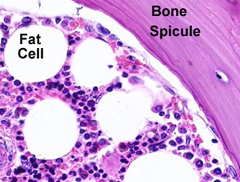Hematopoiesis, the process of blood
formation, in adults occurs in bone marrow, under normal
circumstances (Figs. 13-2 and 13-3).
-
 Examine
the marrow cavity of the long bones decalcified and sectioned on
slide 34 and
slide 104. Examine
the marrow cavity of the long bones decalcified and sectioned on
slide 34 and
slide 104.
- Identify adipocytes and estimate
whether this is “red marrow” or “yellow marrow.”
- Note the overall organization of
marrow and identity sinusoids bounded by endothelial cells and
containing circulating blood.
- Identify hemopoietic cords in
the stroma.
- Cells in mitosis should be
visible here.
- Identify the stromal fibroblasts
and large macrophages.
What is the structural
relationship among the endosteum, stroma, hemopoietic cords,
endothelial cells, and sinusoids in marrow?
Clinical note: Since
hematopoietic populations undergo continuous rapid cell renewal,
they are easily damaged by chemo-therapeutic drugs and ionizing
radiation. Want to see how a bone marrow sample is obtained?
Examine slide 153, a section from a
needle biopsy of normal bone marrow which retains much of the normal
organization of the marrow in bone. Identify the cellular
constituents
- Adipocytes,
- Blood sinusoids,
- Hemopoietic cords,
- Megakaryocytes and
- Stromal cells
|
 |
Sketch a region of bone marrow from
slide 153, showing sinusoids, fat cells, stroma, hemopoietic cords,
and if possible megakaryocytes.
Bone marrow
smear. |